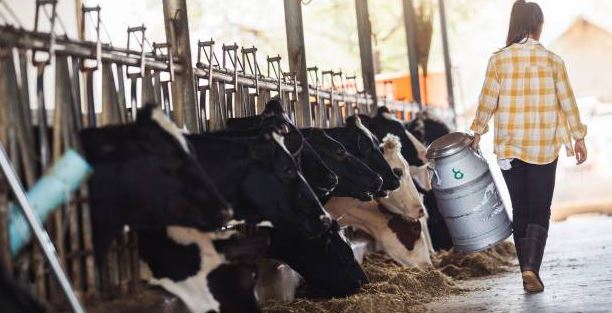The dairy industry plays a crucial role in global agriculture, providing essential nutrients and contributing significantly to the economies of various countries. In any kind of health building diet, milk has a very important role to play. The countries that produce the largest quantity of milk indicates the production strength. From the infants to the adults, demand for milk is for everyone. Here we have listed the top 10 list of largest milk producing countries.
1. United States – 104.1 Million Tons:
USA produces 104.1 million tons of milk annually, topping the globe. Modern dairy farms, technological developments, and a wide variety of dairy products characterize the dairy industry. Wisconsin and California are vital to the US’s vast milk supply, bolstering its worldwide dairy supremacy. The US dairy industry produces the most internationally. With 104.1 million tons, the US serves local demand and supplies the worldwide dairy market. Cutting-edge technology boosts efficiency and productivity on American dairy farms. Wisconsin and California dominate dairy production. Wisconsin’s dairy legacy and commitment to excellence boost U.S. milk production. CA’s vast agricultural land and new farming technologies increase the nation’s dairy supply.
- Also Read: Top 10 Largest Producer Of Tea In The World
2. India – 99.5 Million Tons:
Due to its agricultural past and dairy-dependent population, India produces 99.5 million tons of milk, second worldwide. India’s decentralized dairy business produces significant milk production from small farms. The economy and many dairy farmers depend on this business, affecting rural India. India’s dairy business relies on small farmers. India leads global milk production with their annual yield. This decentralized method ensures widespread dairy sector collaboration for grassroots economic sustainability. Indian dairy is more than an economic sector—it feeds millions of farmers. Rural and national economies depend on dairy farming. The dairy sector provides stability and economic empowerment to many households.
Also See: Top 10 Biggest Dairy Companies In The World
3. China – 40.9 Million Tons:
China is the third-biggest milk producer and one of the world’s top dairy consumers, producing 40.9 million tons annually. The rising middle class and changing diets in China have contributed to the dairy sector’s rapid rise. China’s rise as a worldwide dairy producer has been fueled by this dynamic change in dairy consumption. China’s dairy prosperity is driven by a growing middle class. Dairy consumption has increased as wages grow and lifestyles change. This socio-economic shift has made China a top milk producer. To meet rising milk demand, the Chinese dairy sector is leading the way with advanced farming and technology. This progression emphasizes efficiency, sustainability, and matching different customer demands. Modern farms with innovative technology boost output and help the dairy business meet rising demand.
4. Russia – 32.3 Million Tons:
Russia produces 32.3 million tons of milk annually, fourth-largest. National agricultural environments, notably in the Siberian and Ural Federal Districts, support dairy production. Russia is a global dairy powerhouse due to its vast agricultural lands and robust dairy sector, which combines traditional and contemporary methods. Siberia and the Ural Federal Districts’ vast territories boost Russia’s milk output. The large meadows and pleasant climate make these regions dairy-friendly. Russia’s dairy supremacy increases due to a considerable annual milk supply contribution. Russian dairy mixes tradition and innovation. The industry has modernized its technologies to increase efficiency and output while maintaining heritage. Russia is adaptive in the dairy business due to its history and innovation.
5. Brazil – 24.5 Million Tons:
Brazil produces 24.5 million tons of milk, ninth worldwide, due to its agricultural land. Technical advances, breeding, and milk processing efficiency have grown the dairy business quickly. Minas Gerais and São Paulo considerably contribute to Brazil’s worldwide milk production dominance. Brazilian dairy dominates the globe because to its extensive rural areas. Brazil’s 24.5 million tons of dairy output show its global dairy market dominance and commitment to local and global dairy demand. Strategically integrating technology and breeding approaches helps Brazilian dairy succeed. Dairy cows are healthier and more productive thanks to modern technologies. Innovation and tradition boost Brazil’s dairy industry. Brazil’s dairy industry mainly depends on Minas Gerais and São Paulo for milk production. These areas’ agricultural settings, strategic efforts, and advanced farming technologies benefit Brazil’s dairy sector. Brazil dominates the dairy business due to efficiency and production in these sectors.
6. New Zealand – 21 Million Tons:
New Zealand, noted for its beauty, produces 21 million tons of milk annually, ranking sixth globally. New Zealand supplies global dairy needs as a major exporter. The success and quality of New Zealand’s dairy products depend on grass-fed farming. The dairy industry and natural beauty of New Zealand are famous globally. With 21 million tons per year, the nation serves local and global dairy demand. Focusing on dairy exports boosts New Zealand’s worldwide dairy position. Grasse-fed farms powers New Zealand’s dairy industry. The dairy industry produces high-quality, delicious milk from its beautiful meadows where cattle graze. New Zealand’s commitment to sustainable and traditional agriculture sets it unique globally and complements consumer desire for natural and ethical products.
7. United Kingdom – 15 Million Tons:
The UK produces 15 million tons of milk annually, ranking seventh globally. British dairy farms vary from large commercial to small family-owned. Combining tradition and technology, Devon and Cumbria show the UK’s global milk production leadership. The UK’s 15 million tons of annual output fulfill local and global demands. The British dairy industry’s mix of large commercial farms and smaller family farms illustrates its adaptability and longevity. This diverse structure fosters dairy sector economic sustainability and cultural variety. Devon and Cumbria produce most UK dairy. These sites symbolize the British dairy industry’s dilemma between tradition and modernization. Modern and traditional agricultural methods create a dynamic ecology that fulfills consumer needs and preserves British dairy farming.
8. Mexico – 13.25 Million Tons:
Mexico produces 13.25 million tons of milk yearly, sixth globally. Mexico’s dairy industry is essential to its economy and culture. Mexico’s dairy sector uses innovative farming technologies to meet population demand and enhance production. Mexico’s 13.25 million tons of dairy exports make it a global economic and cultural power. Beyond numbers, the industry enriches Mexican gastronomy and drives the economy. The Mexican dairy industry adapts to increased demand. Efficiency and consumer satisfaction are stressed in modern agriculture. This intentional use of technology and contemporary ways reveals a desire to strengthen Mexico’s dairy sector’s economic and cultural identity.
9. Argentina – 12 Million Tons:
Argentina produces 12 million tons of milk yearly, ranking tenth. Argentina has large grasslands perfect for dairy production, which is why its dairy business is successful globally. Argentine dairy farmers use sustainable and natural methods to create high-quality milk. Argentina’s 12 million tons of dairy exports show its significance. Argentina’s dairy business benefits from its abundant grasslands. Geographical advantages improve milk quality and business expansion. Sustainable and ecological farming is Argentine dairy producers’ goal. That dedication shapes the country’s dairy narrative beyond production metrics. Argentina prioritizes ethical and environmental standards to maintain its dairy industry and provide high-quality, ethically sourced milk.
10. Canada – 10.33 Million Tons:
Canada produces 10.33 million tons of milk yearly, ranking tenth. Due to its high quality standards and solid supply management system, the Canadian dairy industry is a worldwide example of stability and sustainability. Quebec and Ontario are vital to Canadian milk production. Canada is the world’s tenth-largest milk producer due to quality and supply management. These programs create a resilient and sustainable dairy industry, making Canada a global leader in responsible dairy production. The Canadian dairy sector thrives on quality. This ensures high-quality dairy products and consumer confidence in Canadian dairy. A solid supply management system stabilizes and sustains dairy output.
Conclusion:
The global demand for milk production is increasing day by day, and these countries are handling this demand with their updated system. The modern milk production options have been technologically bettered. New options are opening up for smoothening up the transport of the milk as well. No wonder the global dairy industry is greatly supported by them.

Brandon is the cheif editor and writer at WorldUnfolds.com. With a passion for storytelling and a keen editorial eye, he crafts engaging content that captivates and enlightens readers worldwide.















